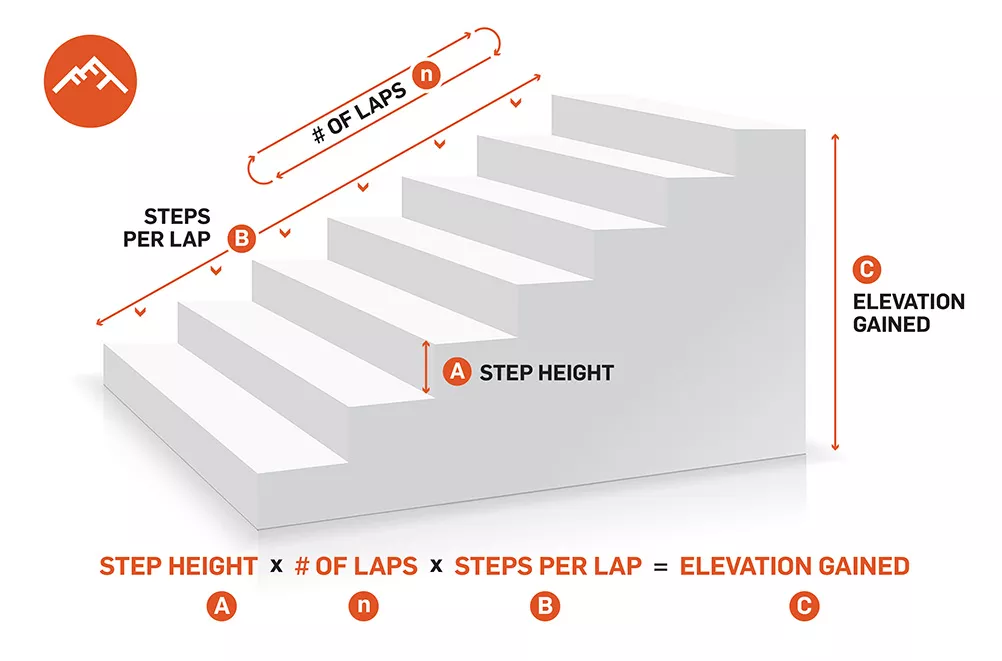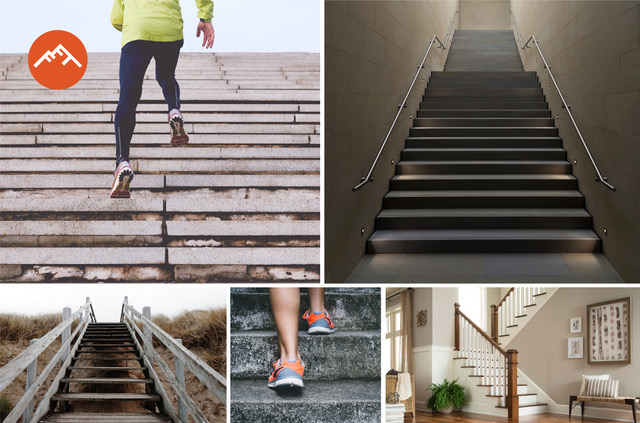Stair Climbing Calculator: How to Calculate Elevation Gain and More

How to Use the Stair Climbing Calculator
*You must first perform these two steps before all the examples below:
1 - Measure STEP HEIGHT and make note
2 - Determine how many STEPS PER LAP you will walk or run and make note. Starting from the bottom stair, count every stair as you walk to the top.
Example 1: How many times do I need to walk or run up the stairs in my office to get 1000 feet of elevation gain?
1 - Click "ft" under ELEVATION GAINED and type 1000 in the box
2 - In the STEP HEIGHT box type in the measurement
3 - In the STEPS PER LAP box type in the number
4 - Your answer will appear in the # OF LAPS box
Example 2: How many flights of stairs equal a mile?
1 - Click "mi" under ELEVATION GAINED and type 1 in the box
2 - In the STEP HEIGHT box type in the measurement
3 - In the STEPS PER LAP box type in the number
4 - Your answer will appear in the # OF LAPS box
Example 3: My itinerary says on Day 3 I will hike a total Elevation Gain of 800 meters. How many times do I need to climb the high school stadium steps?
1 - Click "m" under ELEVATION GAINED and type 800 in the box
2 - In the STEP HEIGHT box type in the measurement
3 - In the STEPS PER LAP box type in the number
4 - Your answer will appear in the # OF LAPS box
Example 4: I am walking up and down stairs in my home 20 times per day. How many feet do I climb every day?
1 - In the STEP HEIGHT box type in the measurement
2 - In the # OF LAPS box type the number 20
3 - In the STEPS PER LAP box type the number of steps you climb
4 - The answer will be in the ELEVATION GAINED box
Example 5: How many flights of stairs is a good workout?
Find any staircase, whether it's in your house or the local high school stadium; it should be anywhere from 15 to 100+ stairs. You will track ELEVATION GAINED to gauge your progress. The workout should be challenging, but doable. Over the weeks and months you can increase the amount of elevation gain. For example, you might achieve 500 ft of elevation gain, then increase to 1000+ ft after a couple of months. Be aware at some point you will plateau and stop improving. That does not mean you should stop. Continue to maintain your stair climbing routine by toggling between long and slow stair workouts, as well as short and fast workouts.
1 - In the STEP HEIGHT box type the measurement
2 - In the # OF LAPS box type the number you achieve in each workout
3 - In the STEPS PER LAP box type the number of steps you climb
4 - The answer will be in the ELEVATION GAINED box. Use this number as your reference and try to beat it every 1-4 weeks.
Definitions
STEP HEIGHT = the height of each stair in inches (in) or centimeters (cm).
# OF LAPS = the amount of times you climb to the top and walk back to the starting point.
STEPS PER LAP = the number of stairs you climb. Count all the stairs from the bottom (wherever you will start your workout) to the top where you will turn around and head back down.
ELEVATION GAINED = the calculation of height [feet (ft), meters (m), miles (mi), kilometers (km)] you would climb on a hike if the treadmill were a hill or mountain trail.
1 LAP = climb to the top of a staircase and back down.
Note: many people use the term "flights of stairs" instead of "# OF LAPS," though both mean the same thing.

